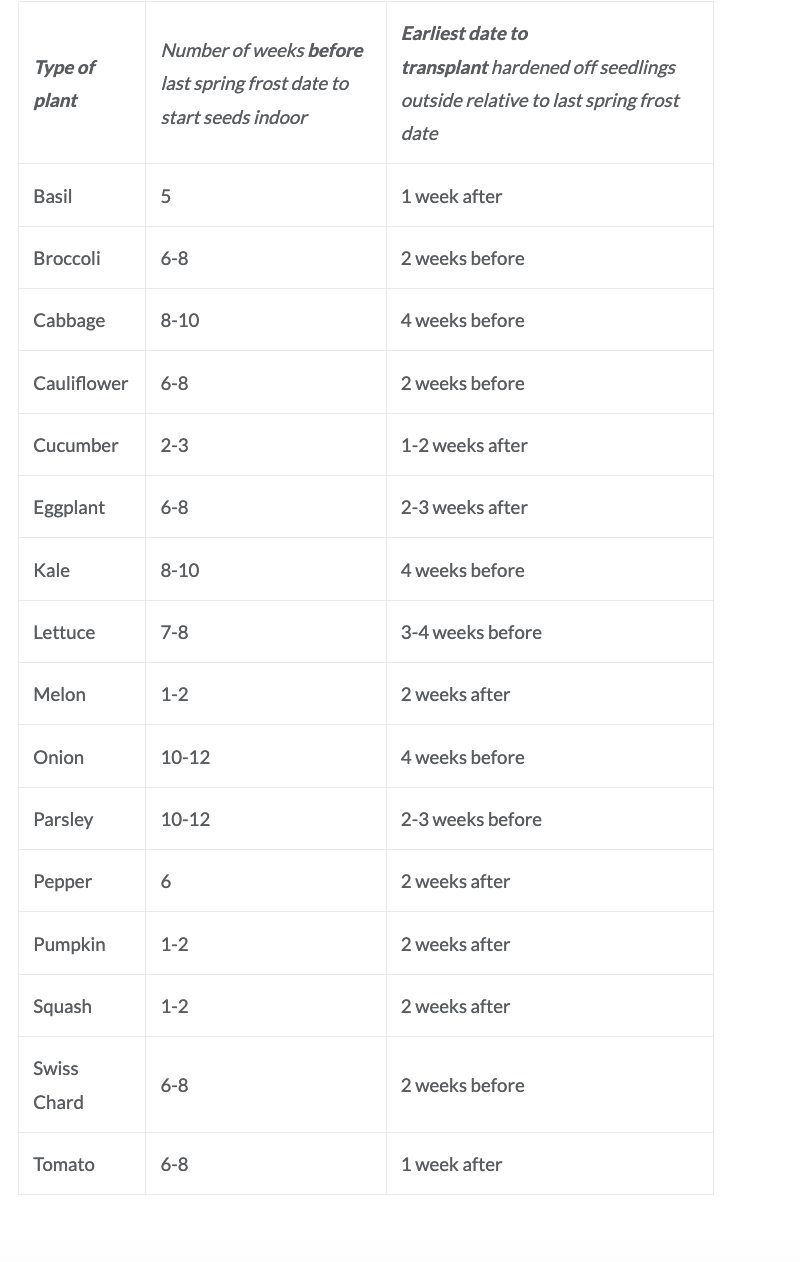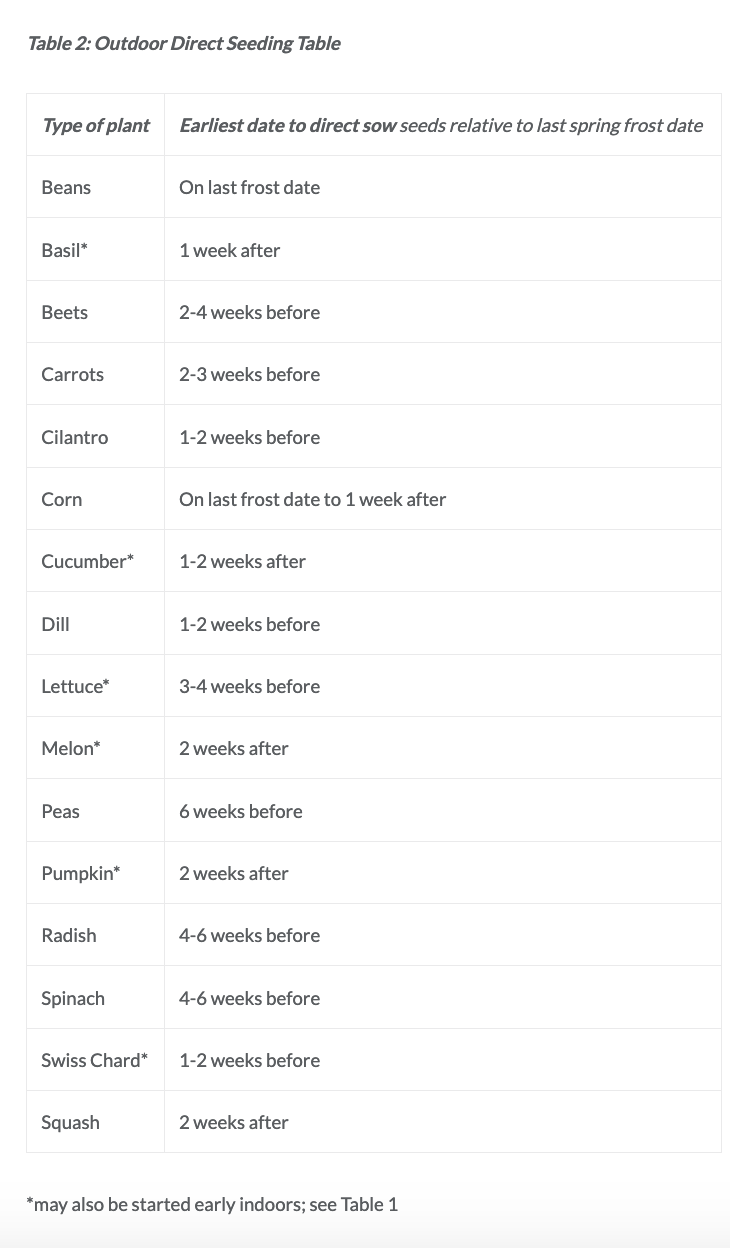
When you’re eager to get gardening, it can be tempting to start sowing seeds as soon as the seed packets appear in garden stores. But correct timing of both indoor seed sowing and outdoor seeding and transplanting is a crucial part of growing healthy plants. Start seeds too early indoors and your seedlings may be leggy and potbound by the time outdoor planting time arrives; too late and your harvest will be delayed. Plant warmth-loving seeds or transplants outside too early and cold soil and air temperatures may harm them. On the other hand, crops that do best in cooler weather may not thrive if they are planted late and end up maturing when the weather is hot.
Fortunately, it’s not hard to come up with a seed starting schedule that is appropriate for your area and the crops you plan to grow. Figuring out what to plant when, both for seeds started early indoors and those planted directly in the garden, starts with finding out the average date of the last spring frost in your area. Then you can arrive at the number of weeks before or after this date to sow seeds of each particular kind of plant for the greatest likelihood of success.
If you are starting seeds early indoors to produce transplants to go out in the garden, your goal is to have transplants reach the best size for transplanting at a time when the weather conditions are suitable for them to go outside. Timing is also important for seeds planted directly in the garden. Cold-tolerant spinach seeds can be planted as soon as the soil is dry enough to work in the spring, while warmth-loving pumpkin seeds should go in the ground
two weeks after the last frost date.
Thankfully, the timing (relative to the last spring frost date) for sowing seeds of vegetables and herbs both early indoors and directly in the garden has been worked out for you by generations of previous gardeners. Check out Seed Starting Tables 1 and 2 (below) for information on some popular vegetable and herbs. Check gardening books and online resources for more comprehensive information. Also look at KidsGardening's Interactive Spring Garden Calendar.
Table 1: Indoor Seed Starting and Transplanting Table


All Gardening is Local
The specific seeding, transplanting, and direct-seeding dates to follow in your garden will depend on where in the country you are. It will come as no surprise that the last spring frost date in Texas comes quite a bit earlier in the year than in Vermont! And in the warmest parts of the country, you may be able to grow some crops outdoors year-round. Your best source of information targeted to the growing conditions in your area is your state Cooperative Extension Service. Many of the state Extension Service websites have seed starting calendars that make it easy to come up with a seed starting and planting schedule for your classroom and garden. The local office of your state Cooperative Extension Service or local Master Gardener program can also help you determine the average last spring frost date (and first fall frost date) for your area.
Make a Seed Starting and Planting Calendar
Making a vegetable and herb seed starting and planting calendar is a fun winter classroom project. It lets you and your students map out in an easy to use visual format when to start seeds of various crops inside to grow into transplants; when to transplant those seedlings outside; and when to plant seeds directly in the ground.
Step 1: Find Your Average Last Spring Frost Date
To get started, find out the average date of the last spring frost in your area. To find this date, consult local experienced gardeners, your local Extension Service or Master Gardener Program, or the National Climatic Data Center freeze/frost information.
Step 2: Make a Seed List
Next make a list of the seeds you plan to start for your garden. Divide the list into two categories: seeds that will be started early indoors to produce seedlings to transplant to the garden and seeds that will be sown directly in the outdoor garden. To figure out which category to place your seeds in, refer to Table 1 (above).
Step 3: Figure out Indoor Seed Sowing and Transplanting Dates
For the seeds you’ll be starting early indoors, find and note the number of weeks prior to the last frost date in your area to start seeds.Table 1 (above) gives you this information for the most commonly grown vegetables and herbs. For plants that are not on this list, check the seed packet, seed catalog, or gardening references for this information. Then translate the weeks before frost date information into the specific dates for your area.
Next, use Table 1 (above) to find out when to move hardened off transplants to the outdoor garden, relative to the last frost date. Some cold tolerant seedlings, such as cabbage and broccoli, can be transplanted before the last frost date, but you should wait until a week or two after your last frost date to transplant warmth lovers like tomatoes and peppers.
It’s important to note that these seed starting and transplanting dates (and those for direct-seeded crops below) are approximate and based on average weather and soil conditions. Use your judgment to modify them (especially transplanting dates) given the actual weather and soil conditions in a particular season. Also note that these dates tell you when you can safely start planting. Some quick-maturing crops, like lettuce, can continue to be planted every few weeks in succession for an extended harvest. And many cold-tolerant crops can be planted from mid-summer through early fall, depending on the crop and your climate, for a fall harvest.
Step 4: Figure out Outdoor Direct Seeding Dates
Some crops don’t transplant easily and they do best if their seeds are sown directly in the garden where they are to grow. These crops include beans, beets, carrots, sweet corn, peas, radishes, and spinach.
Cucumbers, melons, squash, and pumpkin plants also do not transplant readily. They can be started early indoors if the seeds are sown in plantable, biodegradable pots, such as peat pots, so that their roots are not disturbed when they are transplanted. Starting seeds of these crops early indoors may be helpful if you garden in a part of the country with a very short growing season. But in general these crops will do best if they are grown from seeds planted directly in the garden.
Some direct-seeded crops are very cold tolerant and can be planted before the last frost date. For example, spinach seeds can go in the ground as soon as the soil is dry enough to work in. Other seeds, like those of squash and pumpkins, need to be planted when the soil is warm and all danger of frost is past, usually a week or two after the last frost date. Table 2 (above) gives you the timing relative to the last frost date to direct sow seeds in the garden. As you did before, translate the weeks before or after the last frost date into the specific dates for your area.
Step 5: Put All Your Information in a Chart
Now comes the fun part! On a large piece of poster board, draw a table that lists date and the number of weeks before and after last frost for these date in your area the across the top, and the names of the vegetables and herbs you plan to grow in a column on the left hand side. Then using the information you’ve put together, block out the appropriate times for sowing seeds indoors, transplanting, and/or direct seeding for each crop, using different color blocks for each category.
Once your chart is made, it’s easy to keep track of when to start planting seeds both indoors and out, and when it’s time to move your seedlings to the big world of the outdoor garden. Happy planting!
Click to Download this Resource
Download Seed Starting Tables
KidsGardening.org is a national nonprofit focused on creating opportunities for kids to learn though gardening, engaging their natural curiosity and wonder by providing inspiration, community know-how and resources to parents and educators. Our website features a wide variety of lesson plans (https://www.kidsgardening.org/lesson-plans/), garden activities (https://www.kidsgardening.org/garden-activities/) and an extensive toolbox of gardening content(https://www.kidsgardening.org/gardening-toolbox/)





